Rishad Tobaccowala's Blog, page 18
September 11, 2022
Re-thinking Strategy.
 What is strategy?
What is strategy?Strategy is Future Competitive Advantage.
What will the future look like? What will people need and expect? How will demographics, technology and other global shifts create new competitors or recharge current competitors and how will categories blur, blend and maybe even disappear?
Amidst these new expectations and changing competitive dynamics what advantage will your company offer? A differentiated or better product? A competitive moat of network effects, scale or some other dynamic? A better experience? Speed and value?
Very few companies even today get strategy right primarily because they do not understand the exponential impact of technology but also because they make the cardinal mistake of defining their category and competitive set looking backward versus forward.
One example among many is the auto category which defined the key drivers of their category in ways that did not see a Tesla or an Uber for years after they began to scale. How could software be as, if not more, important than hardware? How could electric be better than internal combustion engines? Do most people need the expenses of owning cars or do they just need on demand mobility?
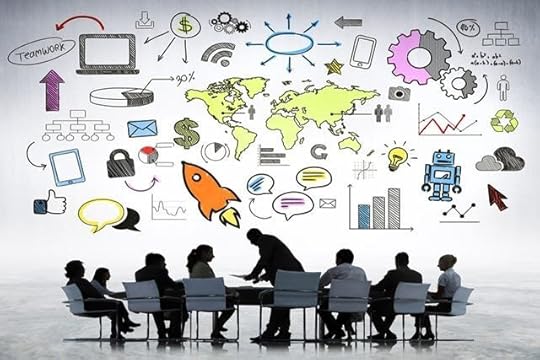 Why the strategy of every organization needs to be re-thought.
Why the strategy of every organization needs to be re-thought.If a key to strategy is the future what happens when the contours of the future shift dramatically?
In the past five years things have become far more complicated.
More moving parts, buzzing around at faster speeds in ways that are more interconnected to each other.
Many of the assumptions that underpinned strategy have not only shifted but, in some ways, the exact opposite of what firms believed is coming true.
Here are just a few “beliefs” that now need to be queried:
a) Expanding populations: When calculating “Total addressable market” or “rate of growth” most companies factored in growing populations.
Now the exact reverse is beginning to happen. Populations have started to decline in most advanced economies at a frightening rate.
b) Scale is a competitive advantage: While scale still matters it matters far less than ever before (except for a few businesses where it matters even more) and the very nature of what is scale is changing with many old forms of scale being competitive disadvantages!

c) Capital and talent are in abundant supply: Capital continues to remain in abundant supply but has become a bit more selective, but talent is in such short supply that the greatest ROI for businesses may come from unleashing the untapped capacity of their talent. Return on Human Capital will be a key measure of return joining Return on Capital and other metrics.
Population declines in advanced markets.It takes 2.1 children per woman to keep the population flat.
That number in most advanced countries is less than 1.7 and declining.
The latest UN projections suggest that the world’s population could grow from 8 billion people to a peak of 10.4 billion before the end of this century. But if we exclude population growth in Africa the population of the world has peaked and, in a few countries, we are starting the great shrinkage.
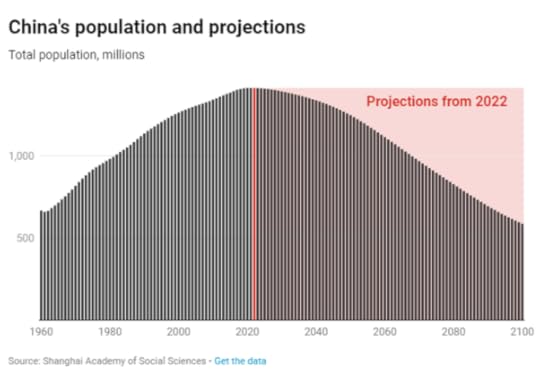
The Shanghai Academy of Social Sciences team predicts an annual average decline of 1.1% beginning in 2021 pushing China’s population down to 587 million in 2100, less than half of what it is today.
Every business should interrogate their strategy to ask two questions a) how will our plans be impacted in our key markets with declining populations and b) what is our plan for the continent of Africa which will contain more 40 percent of the global population in 2100?
 Scale may no longer be the competitive advantage we think.
Scale may no longer be the competitive advantage we think.One of the long-standing tenets of business are the advantages of scale.
Scale has provided companies with many benefits from higher margins due to lower costs, to insulation from competition due to moats of marketing spending and widespread distribution.
Over the past decade however the benefits of scale have diminished and in some cases are proving to be a disadvantage:
Scale of Distribution: With direct-to-consumer marketing enabled by the Internet and platforms like Shopify, widespread retail distribution is no longer as effective an advantage. Clearly distribution matters but there are ways to route around the big stores by going direct and creating demand that forces buyers to stock your product.
Scale of Communication: New media behaviors by people particularly search and social are leading to communication channels where spending power is no longer a competitive edge as it was in television or print where marketers cornered key inventory at advantageous prices. Platforms like Facebook enable millions of small businesses with personalization and targeting capabilities to discover customers and be discovered. As content supported by advertising declines to less than a third from nearly two thirds (scale of spending while still being important is losing its potency.
Scale of Manufacturing: The “Everything as a service” platforms from Amazon Web Services to Foxconn allow smaller companies to gain the edges of scaled manufacturing, distribution, and technology without any of the legacy disadvantages of size.
Scale of People: From IBM to GE to Unilever to Walmart there are hundreds of thousands of employees and therefore ability to recruit and grow a range of talent and offer career advancement. Scale of people continue to be important to execute complex and large tasks but there are also new ways to re-aggregate talent. And a generation of talent wants to work in smaller and more entrepreneurial environments. In the post Covid world as we move to unbundled workplaces there will be far more ways to build teams both globally and in real time than ever before.
Legacy scale still matters in most industries and is critical in quite a few like semi-conductors. In fabricating advanced chips, a new fabrication plant can cost over 4 billion dollars and there is no way around scale. Today TSMC (Taiwan Semiconductor Manufacturing Company) dominates due to its scale.
However, while we can never underestimate legacy scale, there are new forms of scale that every smart company recognizes and is expanding into.
Here is the gentleman with the greatest following on You-Tube who launched the first of a chain of pop-up burger restaurants last Sunday.
 The New Scale.
The New Scale.Scale of Data: Increasingly companies are realizing that collecting, refining, and leveraging data is what is driving the modern fast growing and highly valued companies from Amazon to Google to Uber. Data enables a new form of scale which is that of mass personalization.
Scale of Networks: On the Internet network effects play a dominant role in creating winners. Dominant platforms such as TikTok, Facebook, Netflix, and Tencent (WeChat) enjoy flywheel effects of more users attracting more users and therefore marketers and businesses.
Scale of Influence: Today individuals have tens of millions of Instagram followers or leverage Twitter and TikTok to reach hundreds of millions of people with single posts and tweets. If you look at scaled entities on social media, they are individuals. People are seen as authentic and certain folks like Elon Musk can move markets.
Scale of Talent and Ideas: One of the lessons of history is that every advance in technology places a premium on superior talent. Technology is a lever and when married with great talent a company enjoy major scale effects.
A vivid example of how the new scale works is Kylie Cosmetics. Kylie cosmetics was launched by Kylie Jenner to sell lipstick. In less than two years Kylie Cosmetics sold 900 million dollars of product making the 21-year-old the fast billionaire ever. Kylie cosmetics had less than 50 full time employees, outsourced manufacturing to Seed Beauty a contract manufacture and all e-commerce and fulfillment to Shopify. The single media channel besides PR that Kylie Cosmetics used was Kylie Jenner’s Instagram account with 120 million followers+ (more than the ratings of the top 10 prime time television shows combined)
And even new scale can be disrupted as TikTok’s focus on video and entertainment and a new algorithm allowed them to overtake Meta indicating that Meta’s multi-billion-person social graph which married great data and network effects of new scale could not stop a juggernaut from rising in less than five years!
One of the areas every leader should study is where the Internet is heading. Web 3, Metaverses, Tokens/Wallets and DAO’s have many challenges and noise around them but they are truly revolutionary and will accelerate power to talent and individuals in exponential ways.
Ideas and talent are the true moats everything else can be bought pennies on the dollar.
 The scarcity of talent.
The scarcity of talent.Talent is all. Talent is in short supply. Talent needs to be paid attention to if any strategy is going to work in the future.
The charts above which are for the United States indicate the scale of the challenge anyone hiring talent in the US will face as populations age, immigration stalls while the number of jobs grow.
Add to that the reality that over a quarter of people have moved hundreds of miles from their original office, many people have side-gigs and have begun portfolio careers and that one can work for a spectrum of global companies from anywhere where one has a good Internet connection!
Growing, leading, attracting, retaining, and investing in talent is going to be a key strategic advantage.
Every human and individual and employee with the right support and placement can be highly productive and valuable.
Every strategy deck should have a significant section on unleashing talent and not of competitive dynamics, financial metrics and total addressable market and other data.
Companies grow when talent grows.
Next time you here about a company changing their CEO no matter what they say what is really happening is one or more of the following:
a) They have over invested in China or have overestimated growth in and therefore the total addressable market in the US, Europe, Korea, and Japan.
b) They have over built particularly too many stores or too many theaters or just too many thinking they could crowd out competitors. Now they have a sea of sameness that looks dated and is a legacy cost versus an asset.
c) Their leadership has a talent problem or there has been a break down in the social contract between the people who do the work and are on the frontlines and management.
September 4, 2022
Architecting Joy.
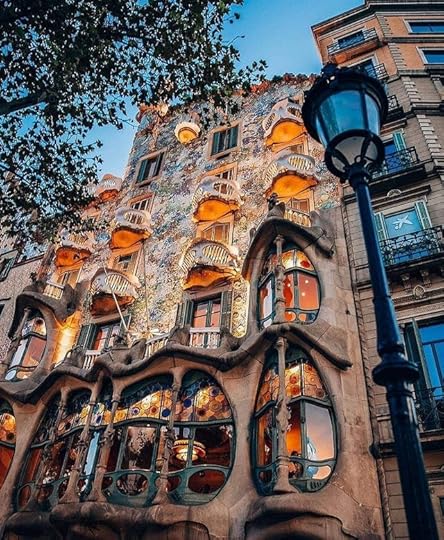
A definition of success is the freedom to spend time in ways that gives one joy.
Joy is more than happiness which is often transitory as it ebbs and flows with external events.
Joy is more akin to contentment and satisfaction.
Some believe it is momentary suggesting we have “flashes of joy”.
The joy that comes with deep satisfaction and contentment however endures and its contours do not waver with the oscillations of the transient.
Experience, time, and observation reveals there are ways to architect joy.
 Joy=Grace+Flow+Connection.
Joy=Grace+Flow+Connection.Joy encompasses grace, flow, and connection.
The joyous exhibit graciousness, they tend to be in a state of flow and connected to both reality, other people, and some things higher and deeper.
 Grace.
Grace.Grace is a fusion of demeanor and deportment.
The graceful combine a generosity of spirit, a sense of respect for others and a humility regardless of their level of excellence and skill.
Generosity of spirit in understanding that much of what is meaningful is not a zero-sum game.
Respecting others by being aware of them and their needs and backgrounds.
Humble in not losing one’s sense of perspective that everybody’s achievement while significant is due to a combination of many factors including luck, opportunity, inheritance, and the specific time and not just due to skill and hard work.
 Flow.
Flow.When in a state of flow an individual is inside and outside time.
Deeply immersed in something while extracted from the ordinary.
It can come in many ways including working on something which is challenging to stretch one but not so difficult that one cannot achieve positive outcomes.
It can come from being immersed in making things, building things, and creating things.
And it comes from learning and seeking wisdom. In being able to connect the dots and see and understand things in ways that give one joy.
 Connection.
Connection.The joyous seem to have strong relationships to other people and to a higher cause or purpose.
Humans are social beings and most need some form of connection. The ability to invest and grow connections tends to be associated with joy.
In addition to these human/family connections many gain joy by connecting to a higher cause or purpose.
It may be a charity, it may be a social cause, a striving quest, or some form of a religious or spiritual endeavor.
 The stones used to architect joy.
The stones used to architect joy.Generosity. Respect. Humility engender Grace.
Creating, Learning, Challenges enable Flow.
Relationships. Purpose. Spirituality elicit Connection.
Intriguingly these are human and not specific to an industry, a race or country.
They sometimes result in fame, power, and money but they can thrive in the absence of these.
Try to create and build and learn. Invest in relationships and respect others without being full of oneself. Find a cause or calling.
By mindfully focusing on and spending one’s time in these ways this one can architect joy.
August 28, 2022
What’s Next?
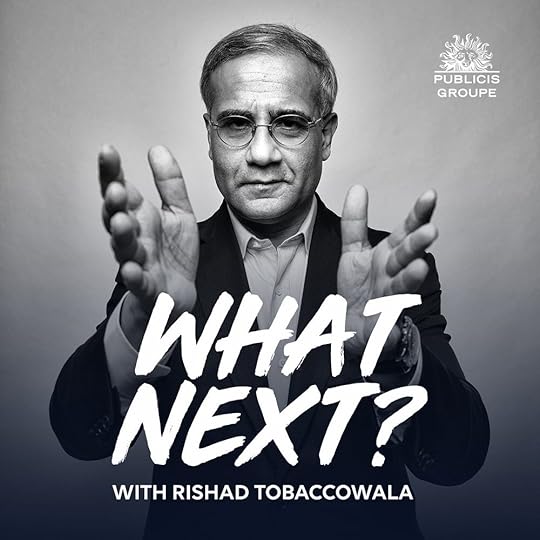
This thought letter the “The Future Does Not Fit into The Containers of the Past” is now 2 years old.
It launched with the goal of being a gift that was 100% opt-in, completely free, and bohemian in nature covering a range of very different topics but infused with a growth and future mindset.
Despite zero advertising the thought letter is read by about 25,000 people every week.
It has found its audience by being mentioned at speaking events and a weekly social media post on LinkedIn, Twitter, and Facebook. But most of the audience has been built by readers forwarding to their friends, colleagues and organizations and positive word of mouth.
Reflecting the diversity of topics it is read globally by thousands of people early in their career and by over 500 CEO’s and Presidents of companies. Readers work in a range of industries across business, finance, academia, art, science and technology.
Thanks for the support.
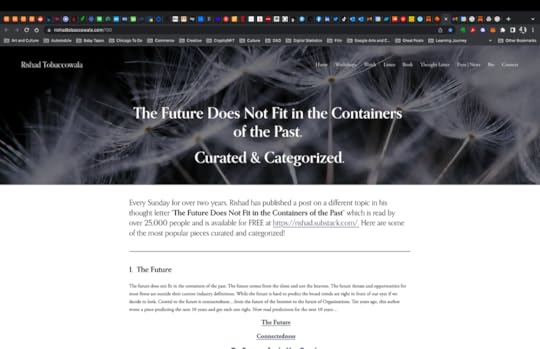 The Future…” now easy to access, continuously updated, and quickly shareable!
The Future…” now easy to access, continuously updated, and quickly shareable!At the request of readers who would like a way to easily access the past two years of writing (since I do not write about news, current events, or politics almost every piece is as relevant today as when it was written) I have launched a continuously updated page that is easy to bookmark and share.
The page curates and organizes the writing that has resonated the most into twelve different categories that people care about from “The Future” to “Becoming a Leader” to “Selling Better” to “Upgrading Our Mental Operating Systems” to “Managing Careers” and much more.
The page can be found here: https://rishadtobaccowala.com/100
If you would like to introduce someone to my writing and thinking please share this post or the link above! Share
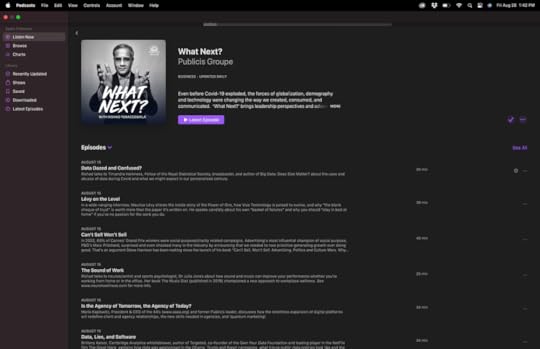 What Next? Podcast.
What Next? Podcast.Two years ago, around the same time I started publishing this thought letter, I began hosting a podcast called “What Next?” for the Publicis Groupe where I had spent my entire 37 year full-time working career and to whom I have been fortunate to remain connected as a Senior Advisor.
In the 65 episodes recorded to date, I have spoken with a spectrum of people including historians, scientists, entrepreneurs, business leaders, venture capitalists, marketing leaders, advertising giants and many others on what they believed the future held and how we could align ourselves and transform our companies to thrive in such a future.
Until now “What Next?” had been available only to the 87,000 global employees of the Publicis Groupe but now with the release of 8 Episodes it is now available on all major podcast platforms including Apple and Spotify. A brand-new episode will be released each weekend.
There are some amazing guests who have already been recorded and scheduled to appear over the coming months.
The readers of this thought letter may find the podcast series relevant for three reasons:
Just like this thought letter it is focused on the future and how we can grow and transform to thrive there.
Like this thought letter it is a gift completely free of subscription fees or advertising.
The two share a common voice and writer but the podcast also brings in a diversity of amazing voices.
The first 8 episodes (each about 30 minutes and tightly edited to maximize insights per minute and respect your precious time) reflect this spectrum and diversity in the range of guests. Listen to any that catches your fancy. If you listen to a few you will realize how diverse in topic, mindset and perspectives each are.
Here is a brief summary of each of the 8 episodes:
Four predictions by a $20 Billion Deal Broker You Don’t Want to MissTerence Kawaja, CEO, and co-founder of LUMA Partners, is the dealmaker in the media sector. Check out this episode where Terry (as he is known to friends) predicts “zero-based calendaring”, how marketers need to “portfolio re-balance” their spend from physical retail to e-commerce in a rapidly changing commerce landscape post-covid and where the metaverse will be found (and it’s not on our heads).
From the BBC to B2C
In a very special episode, Rishad talks to renowned historian, award-winning BBC broadcaster and digital business entrepreneur Dan Snow. They explore how Dan has accelerated away from traditional broadcast to build an agile and successful digital content business by exploiting the impact of digitization.
Data, Lies, and SoftwareBrittany Kaiser, Cambridge Analytica whistleblower, author of Targeted, co-founder of the Own Your Data Foundation and leading player in the Netflix film The Great Hack, explains how data was weaponized in the Obama, Trump, and Brexit campaigns, what future public data policies look like and the opportunities to grow beyond the big platforms.
Is the Agency of Tomorrow, the Agency of Today?
Marla Kaplowitz, President & CEO of the 4A’s (www.aaaa.org) , discusses how the relentless expansion of digital platforms will redefine client and agency relationships, the new skills needed in agencies, and ‘quantum marketing’.
The Sound of WorkRishad talks to neuroscientist and sports psychologist, Dr Julia Jones about how sound and music can improve your performance whether you’re working from home or in the office. Her book The Music Diet (published in 2019) championed a new approach to workplace wellness. See www.neuronwellness.com for more info.
Can’t Sell Won’t SellIn 2022, 85% of Cannes’ Grand Prix winners were social purpose/charity related campaigns. Advertising's most influential champion of social purpose, P&G's Marc Pritchard, surprised and even shocked many in the industry by announcing that we needed to now prioritize generating growth over doing good. That's an argument Steve Harrison has been making since the launch of his book "Can't Sell, Won't Sell: Advertising, Politics and Culture Wars. Why ad land has stopped selling and started saving the world". Here he discusses what the IPA called "the most provocative advertising book in years" in what could well be Rishad's most provocative podcast in years!
Lévy on the LevelIn a wide-ranging interview, Maurice Lévy shares the inside story of the Power of One, how Viva Technology is poised to evolve, and why “the blank cheque of trust” is worth more than the paper it’s written on. He speaks candidly about his own “basket of failures” and why you should “stay in bed at home” if you’ve no passion for the work you do.
Data Dazed and Confused?Rishad talks to Timandra Harkness, Fellow of the Royal Statistical Society, broadcaster, and author of Big Data: Does Size Matter? about the uses and abuses of data during Covid and what we might expect in our personalized century.
A great team spread around the globe puts this together:
Executive Producers: Christopher Harrison and Severine Charbon
Producer: Lara Parker
Audio Engineer: George Turner
Audio Engineer: Michael Powell
Sound Designer: Grzegorz Fiedorowicz
Project Coordinator: Anne Bor Gloaguen
Communications Consultant: Karen Lim
Host Photo: Emmanuel Andre
Theme Music: So Solid Sounds
Post Producer: Zuzanna Brzezinska
Editors: Mark Jewitt / Gilly Smith
You may want to subscribe by clicking by on the the words “ Apple” or “Spotify” below (The podcast has been distributed globally across most if not all platforms and not just Apple and Spotify).
You might find them intriguing, interesting and irreverent!
Thank you!
August 21, 2022
Embracing Excellence.

Over the years some simple and impactful pieces of advice:
“Find something or somebody to admire”
“Observe excellence”
“When you reach for the stars, you may not quite get one, but you won't come up with a handful of mud either”
We all have limited time, and we can spend it engaging with people and things that we admire, or we can spend it looking down on people and discussing what angers, disappoints and troubles us.
There will always be things that enrage us and gets us upset and these are readily served up by todays algorithmic mediascape.
But focusing our attention this way may leave us empty, spent and not any better off than we were before.
But, if we focus on excellence and learning from people or things. we admire we are more likely to come away fulfilled and inspired, wanting to reach higher and strive for growth.
Every few weeks this thought letter will focus on something or somebody that the author believes is “the absolute best in the world bar none” and that is available to everybody for little to no cost that bears listening to, watching, or engaging one’s attention with.
Today it is a television series that will make you feel, see, and think differently about yourself, other people, how to look and listen and much more.
It is not just a great body of work but a work of art that will reverberate for years.
 The best television show made to date.
The best television show made to date.A case can be made that we are living in the greatest time for television.
There are nearly 500 scripted shows in the United States alone. Modern digital tools and competition for content among a plethora of streaming services are enabling more voices and more shows to be more available to more people than ever before.
And at the same time our televisions are getting larger with better pictures and sound (listen with wireless headphones for a theater experience) and streaming gives us the opportunity to eliminate commercials and to consume the story telling on our own schedules.
The pantheon of great shows span the world and include shows like “Borgen”, “The Bridge”, “Fauda”, “The Bureau”and many more from outside the US and “The Sopranos”, “The Wire”, “Mad Men” and “Breaking Bad” from the US.
And then there is one that matches the quality of these legends but could be the best television series made to date.
A series that ended this week after six seasons spread over 7 years and 63 episodes and is now available worldwide on Netflix and other platforms.
Better Call Saul!
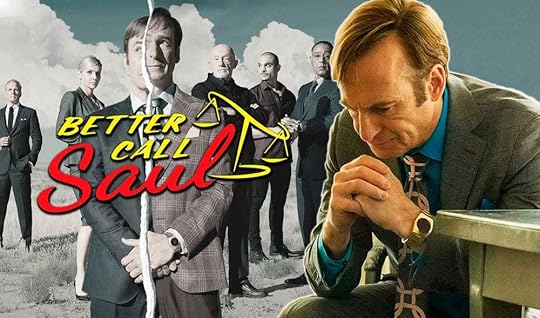 Why Better Call Saul?
Why Better Call Saul?Better Call Saul is a prequel to Breaking Bad which is usually on the list of the best two or three television shows ever. It is the story of how one of the main characters of Breaking Bad a lawyer called Saul Goodman came to be.
Over the years the prequel went from being very good to being the equal to and then maybe better than the original.
How does one reach for excellence? By focusing on five things that this television series personifies:
Emphasis on talent.
Culture of excellence and teamwork.
An attention to and sweating of details.
Aligning with and leveraging technology.
Respecting and trusting viewers.
1) It all begins with talent: The show runners and much of the crew of Breaking Bad worked on the new show and many of the stars of the first show play roles on the new show joined by many new actors. You begin with world class talent and stir in years of experience, and you have magic!
2) Culture of excellence and teamwork: Because of the quality of Breaking Bad talent of every sort wanted to work on the new show. But it was not just the quality of Breaking Bad that attracted talent but also for the atmosphere and culture of diversity, fairness, empowerment, and teamwork that made for an amazing working atmosphere which made everyone jump at the opportunity to work on the new show. There was an emotional buzz to every day of production that ran across everyone from the main stars to the carpenters working in the prop department. This showed in the work. You can feel it here in the out takes on the last day of the set.
3) State of the art craft and attention to detail: The late Roger Ebert quoted Howard Hawks who said a good movie has “Three great scenes. No bad scenes”. As we get into the later seasons of “Better Call Saul” we have three or four or five great scenes in an hour and there is no single episode among the 63 episodes that will not make you stop and say, “I have never seen anything like that before!” or “How did they do that?” From scripts that are written by wordsmiths who do think visually, to casting that is perfect to editing and lighting that moves you this show has it all.
The attention to detail includes the need for space and silence.
Here is an article in the Wall Street Journal titled…How Better Call Saul Redefined the Art of Television and contains this quote…The visual language of “Saul” begins with its writers. Their breakdowns of how scenes should look are more extensive than those in typical TV scripts. “A lot of people think writing is about dialogue, but for us it’s the spaces in between the dialogue that are the most important,” Mr. Gilligan says.
4) Leveraging technology to enhance storytelling: This show looks and feels different because its creators understood how television technology at home was changing and also how modern digital cameras and editing was enabling storytelling in new ways. From “How Better Call Saul Redefined the Art of Television”:
In its final episodes, the prequel has caught up to the timeline of “Breaking Bad.” When that show first hit cable in 2008, more and more viewers had flat, wide-screen TV sets in their homes, but many TV directors had not yet abandoned techniques used for old-fashioned squarish screens, says Mr. Gilligan, who created “Breaking Bad.”
“Everyone was still framing claustrophobically tight,” Mr. Gilligan recalls. For today’s TV screens with similar proportions to cinema screens, “I wanted to frame in the way John Ford and Akira Kurosawa did, to crib from two of the greats. We tried to make ‘Breaking Bad’ look as much as we could like a western.”
“Saul,” also set in Albuquerque, N.M., premiered in 2015. Before production started, Messrs. Gilligan and Gould presented a slideshow for their crew with images from films they wanted to use for inspiration. They included 1970’s “The Conformist,” known for director Bernardo Bertolucci’s unique angles and framing.
Because the later seasons of Better Call Saul were produced a decade after Breaking Bad ended the better technology truly enhances the visual aspects of the story telling. Here is just one scene less than two minutes long that took days of filming:
5) Respecting/Trusting viewers: Some of the best art and storytelling in the world is effective for what it leaves out or does not depict as much as what it leaves in or depicts. Many of the most powerful scenes and storytelling in Better Call Saul trusts the audience to connect the dots and fill in the blanks.
More is less when you respect the audience.
Learning how excellence is sculpted.Not only is “Better Call Saul” among the best if not the best television show but it’s companion podcast is possibly the best free master class one can get on every aspect of how excellence is sculpted.
Unlike other podcasts about television shows this one is unique in what it covers and who appears in it.
First, it is not about what happened in each episode but on how the episode was crafted. Not the entire episode but maybe two or three key scenes.
Second, the creators of the show Vince Gilligan and Peter Gould participate in each podcast and the guests are not just the actors/actresses but make up-artists, sound engineers, editors, directors of photography, script writers, location scouts, prop creators, music choreographers and the entire spectrum of talent that goes into the making of the show.
It is a master class that will blow your mind on not just how this show is made but how stories are told, the details that go into each minute and you will never every see, feel or listen to anything you watch in the same way.
A master class on how a masterpiece is created minute by minute, block by block by the people who crafted the masterpiece speaking in english for non-experts.
Here are links to the podcast on Spotify and Apple but it is available free of cost and free of advertising and promotional interruptions on every major podcast platform:
Watch an episode of tv and then listen to an episode of the podcast.
“Big big things inside people.”
In the end what made “Better Call Saul” was its delicate and nuanced understanding of humanity.
It combined the quest and search of Homer’s “Odyssey” with the comedy of “The Simpson’s” Homer Simpson. It mixed tragic elements of Shakespeare with the uplifting elements of the redemptive power of love.
It was about the complexity of individuals and the forever journey of becoming.
It was a series that was constrained in one way that it needed be true to its sequel but as the best creative people have always stated there is nothing as powerful as a tightly constrained brief to unleash the powers of imagination and storytelling.
In one way this is much ado about a fictional story and a television show.
But in the end that is all we are.
We are stories and one person is many stories.
Joan Didion wrote “we tell ourselves stories in order to live”.
Like most great art, Better Call Saul makes you feel more alive when interacting with it and transforms your perspectives long after the experience.
August 14, 2022
De-Bossification.
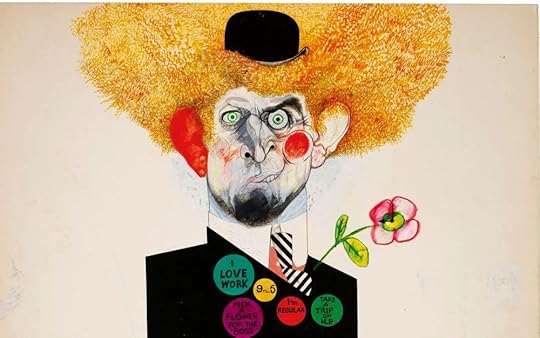
Art by Ralph Steadman
In many industries particularly “White-collar” ones the era of “bosses” is in decline.
There is a rise in the need for leaders, guides, coaches, mentors, role-models, creators, and builders.
Less of a clamoring for bosses, managers, controllers, monitors, evaluators, and paper pushers.
This shift has been driven by changing demographics, the spread of technology, the rise of unbundled and distributed work, new behavior expectations, and a re-definition of what “work” is including the rise of fractionalized and free-agent talent who work for themselves or at multiple jobs and are expected to comprise most of the work force in the US by the end of the decade.
For more about these changes please read The Future of Work and The Transformed Talent Terrain.
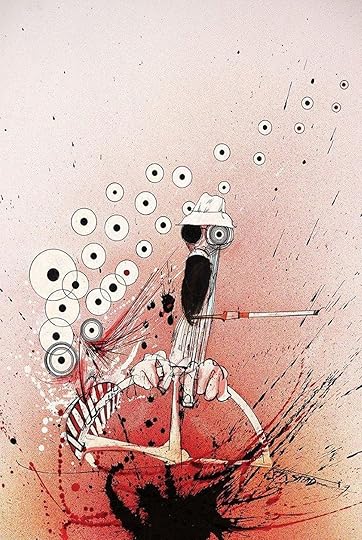
Art by Ralph Steadman
The New Leader.Modern leadership is about zone of influence versus zone of control.
People follow people and not titles.
Leadership is a role and not a job title.
It is a way of being infused with a passion for excellence and a quest for middle to long term multi-stakeholder growth (company, community, employee, leader) versus a focus on the short term and emphasizing only investors/owners.
Most importantly it is about the continuous feedback and learning of a growth mindset.
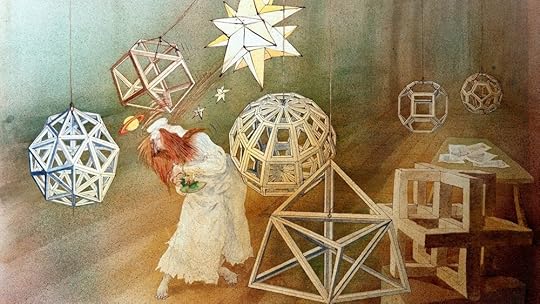
Art by Ralph Steadman
Why the old model is collapsing.Once upon a time a manager controlled the flow of information, access to opportunities and was a font of expertise and craft.
Today the half-life of knowledge is growing shorter and shorter and the “way of this is the way things were done” is often the opposite of what needs to be done as new competitors and customer expectations do not care a fig about the way it was or is.
Talent can find information, opportunity, and knowledge at a click of a mouse or the pinch of a finger and often are working at the other side of the world making monitoring, controlling, and overseeing difficult.
The future does not fit in the containers or the mindsets of the past and many bosses are like sailors navigating their ships by looking at the mirage of a star that has long set.
Every year fewer and fewer people care about the dues paid or the way it was or what was done.
Experience that matters is the ability to practice at the state of art, be at the top of one’s craft, have the ability use previous learnings to find patterns, connect dots in new ways and distill insights.

Art by Ralph Steadman
Transforming from boss/manager to leader/coach is possible for those wishing to try.As times change the best managers adapt and learn and flex into new shapes and learn new skills.
Just because someone has bossy traits and was forged in a different era does not mean they cannot re-invent and re-wire their skills if they want to.
This transformation requires three conditions:
First it requires today’s bosses to accept that to grow and remain relevant they will have to change and while it may be difficult it is better than becoming irrelevant.
It also requires their leaders to ensure that new incentive systems that are more about zone of influence, growth of craft and people versus zone of control of budgets and team size are put into place.
A new way requires new pay.
And there is an urgent need for coaching and training and patience to help today’s managers become tomorrow’s leaders.
A personal hunger supported by new incentives and buttressed with training including the opportunity to self-learn is the formula.
Talent is short and it is a mistake to believe that seasoned employees cannot grow into new potential.
New brooms sweep clean but old brooms know the corners.
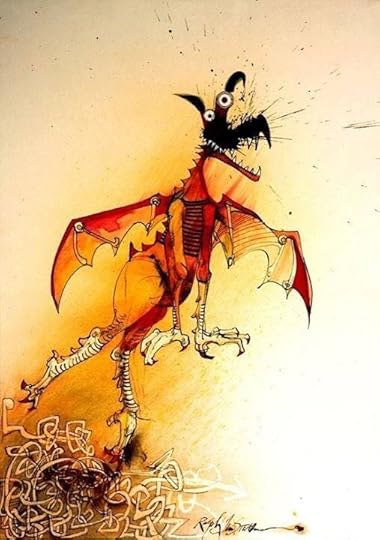
Art by Ralph Steadman
How one can “De-Bossify” oneself.Every human has the potential to grow and change since in many ways growth and change is what life is.
A three-step program:
Make time to learn: To do so requires us to listen to the voices of discontent and concern in our own head that we may be understanding less or lacking skills we need and instead of suppressing these or beginning to be buzzword bingo players spewing the latest in management or tech lingo to wallpaper a lack of understanding we need to go back to school.
Today because of global shifts, demographic changes, advances and technology and the shock of Covid-19 everybody needs to be schooled and no one is alone. Knowledge and skills must be learned and are not immaculately gained.
Challenge ones thinking by seeing at things from outside us: Whether it is getting feedback from others or building a case for the exact opposite way of doing and thinking from the way we currently practice it is important to stretch oneself and look at things from a different vantage point.
Gaining new perspectives via provocations and new point of views can be thrilling and not just chilling.
Do/Build/Create/Practice: Modern leadership is being able to guide through experience. If one wants to learn about the Future of the Internet reading a book on the Metaverse and appointing and delegating to a Chief Metaverse Officer is not enough. One needs to don a VR headset, mint an NFT, get a Meta-mask or other wallet, trade on a De-fi platform…
We are all must be apprentices now if we wish to grow up to be or remain the Magic Sorcerer!
May the force of de-Bossification be with us!
August 7, 2022
Sacred Hours.

Every week contains 168 hours of which 100 hours are spent asleep and at work allowing for the rest of life to fit in 68 hours.
For many the remaining 68 are filled with a hurly burly of responsibilities from child to elder care, cooking, cleaning, errands, medical appointments, commutes and more.
The few free minutes in between are often buffeted with headlines, social media streams looking to colonize our minds and a dozen competing claims on our time and attention.
No wonder that so many feel stressed, fatigued, and frenzied.
As William Wordsworth wrote:
“The world is too much with us; late and soon,
Getting and spending, we lay waste our powers; “
 A special hour every day.
A special hour every day.Some of the most contented and satisfied individuals regardless of their station in life or the pressures on their time and attention, have found a way to create an oasis of stillness and a special sanctuary that helps center them, grow them, and makes each day meaningful regardless of what the world of commerce and competition might bring in setbacks, challenges, and pressures.
They set aside an hour every day for themselves. Not their work, not their families, not for all those who clamor for it or to tackle a list of never-ending to-dos which when allowed to will absorb all free time.
An hour earmarked and blocked by them to spend on themselves.
It might be spent learning, reading, exercising, thinking, meditating, walking.
It is solitary and it is special.
A sacred hour.
Some may think of this hour as a selfish hour but is an hour that allows individuals to be effective and productive in all the remaining hours of their day whether it be at their jobs or tending to their family and social obligations.
 Finding 7 hours a week for oneself.
Finding 7 hours a week for oneself.Surely one cannot be serious that one can find almost a working day of hours for oneself every week?
While not easy there are a combination of four different tactics that one can utilize to free up much more time than seven hours a week depending on one’s responsibilities and flexibilities.
The four tactics are
a) Zero based calendaring to eliminate the unnecessary.
b) Delegation to mitigate the pressures of the necessary.
c) Reduction of frequencies of meetings.
d) Compression of time allocated to a task.
 Zero based calendaring.
Zero based calendaring.In “A Moveable Feast” Ernest Hemingway’s love song to the incredible city of Paris he writes…” If you could keep from making appointments, each day had no limits”
There is nothing as invigorating as an empty calendar. It does not mean that one is not needed but one has the freedom and liberty to spend the day in the way that is most meaningful versus being shackled to a merry-go-round wheel of motion and action that often feign to be important, special, and essential.
What if one begins with an empty calendar wiped clean of all appointments and then transfers only those that you really believe are critical to this new clean calendar? Ask your colleagues and bosses how many of the meetings are just habit and are not necessary or could be a memo or held less frequently.
Just like work expands to fill time available appointments occur to fill one’s calendar.
Start with zero and build back versus trying to trim the bursting to seam calendars that resemble a barnacle encrusted underside of a ship.
 Delegation.
Delegation.The best leaders run positive “Ponzi” schemes. They surround themselves with people better and more competent than them and hand down as many of their responsibilities that they can and encourage them to do the same to the next level.
Everybody is stretched and growing, and their bosses can stretch and grow to the next level.
If one is doing too much it may mean that the people around us are not good enough or we are not growing and stretching them and so in time we will lose them.
We should delegate and do less.
Focus on one’s superpowers, growing others and thinking about the long term.
 Reduction of frequency of meetings.
Reduction of frequency of meetings.Business reality requires budget to status to board meetings for a variety of reasons from fiduciary to the necessary.
But can the weekly meeting be moved to twice a month or maybe once a month?
Does everyone have to attend every meeting?
If presence at a meeting is the way a pecking order is established at a company, we should wonder if this attracts talent or insecure politicians.
Less is more.
 Compression of time allocated to a task.
Compression of time allocated to a task.One of the silver linings of the tragedy of Covid is that one can move from meeting to meeting by moving one’s “mind parts” without physically moving one’s “meat parts”.
This saves a lot of time in travel and other logistics.
Most Boards now meet once every six months in person while meeting virtually in between.
In addition to reducing the need for physical presence at all meetings we may also want to consider reducing the time for each meeting by a third or half. Pre-reads and tight management can significantly cut the time allocated without any significant loss in impact.
Personally, we might shave off a few minutes from our social media usage or Netflix use to enable finding time for our sacred hour.
 How to make the most of one’s sacred hours.
How to make the most of one’s sacred hours.With a little discipline one can find an hour a day for oneself and often more.
How one spends it depends on each one of us but blocking out an hour for oneself every day and ideally utilizing is early as possible before the pressures of the day make one lose control of the best laid plans is ideal.
If every individual looks after themselves, they can do a much better job at their jobs and caring for others.
Because in the end time is all we have and the way we spend our time is the way we spend our lives.
And living our lives as pinballs in a game where someone else is controlling the flippers may be filled with the excitement of velocity and blinking lights but is it our life?
For a few sacred hours let’s make it so.
Photography of The Great Ocean Road, Australia by Rishad Tobaccowala.
July 31, 2022
The Tao of TikTok.
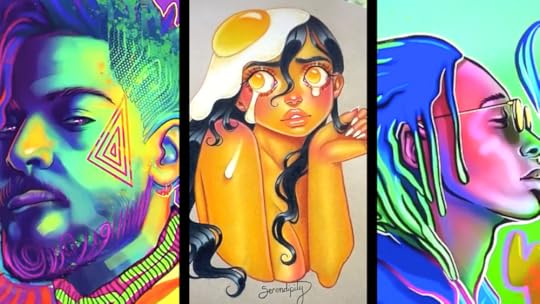
In the past 1000 days the growth of TikTok has disrupted the media landscape.
It has shot past Google to become the most popular domain and the time spent daily on it is greater than all of Meta’s properties (Facebook, Instagram, and WhatsApp) and it is potentially even carving into the time spent watching analog television and Netflix!
It has become the key cultural currency and meme generator unleashing thousands of creators with followings of over a million people all around the world.
This article by Professor Scott Galloway is an absolute must read to understand the breath-taking rise of the platform.
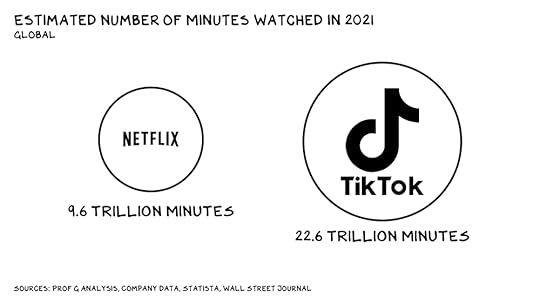
Every individual and business stand to learn lessons from this amazing rise and its implications on the future of business, media, and culture.
 A moat and walled garden can rapidly change to enable self-imprisonment.
A moat and walled garden can rapidly change to enable self-imprisonment.The key asset of Facebook was the network effects of its social graph (all your “friends” were there) making it very difficult to launch a new competing entity. Its network effects, social graph scale and roach motel model of walled garden was a wealth generation engine for the age.
One of the few companies that competed against this social graph with some success was Snap driven in great part by its sheer product and design ingenuity. However its growth was blunted by Instagram carbon copying Stories and leveraging the strength of its scale.
TikTok practiced asymmetric warfare by eschewing the social graph and replacing it with an interest graph. Its algorithm and learning loops allowed individuals to be exposed to a spectrum of great content without having to bring any friends or create any content!
It then positioned itself as an entertainment platform versus a social platform.
Now Meta is responding by dialing down its social graph and working to create intent graphs with its Reels projects and by dialing up algorithmic results versus social graph results injecting all sorts of drugs into Instagram irking its users and creating some lurching Frankenstein mix of image/video and social/content graph.
One should never underestimate Mark Zuckerberg and the very deep talent pool at Meta as they seek to dramatically pivot their business but a lesson to be learned is that assets can become anchors and to win as an outsider one needs to change the rules of the game.
Every company should pay attention to whether what made it great can keep it great and wonder whether its competitors are the usual suspects sharing its perch in heaven or someone emerging from the slime with audacious new rules of engagement.
 Focus and simplicity wins.
Focus and simplicity wins.Everything about TikTok is built around focus and simplicity.
You can start right away and it simple to use. You do not need friends or must create content or enter any data to begin to enjoy the product.
And it is focused.
Just video.
One video that takes over the phone screen vertically.
No distractions.
For the viewer.
But more importantly for the algorithm and the learning models which do not have to deal with anything else.
It sees everything and learns everything fast.
And as your interests change (do you swipe, linger, replay?) it morphs and can stay current with your interests, tastes and passions.
Fast. Clean and Simple.
Companies and individuals who focus on core competencies and keep every part of the experience and what they do as simple as possible tend to win and we see it in spades with TikTok.
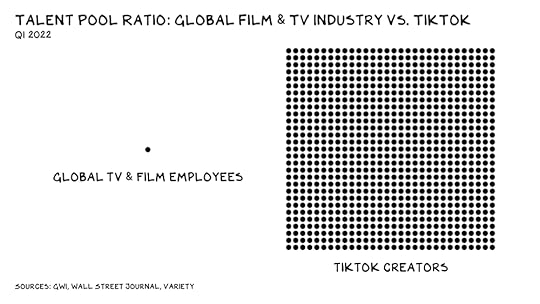 God-Like Power to unleash creators.
God-Like Power to unleash creators.While a significant part of TikTok’s success is driven by its algorithms and training sets based on video usage plus simplicity, a third factor is the very powerful tools it gives creators that make it easy for people who want to create to do so.
This includes all sorts of lenses and filters that give one much of the power of Adobe’s Creative Cloud on a phone with no need for expertise plus music tracks and the ability to sample, build and morph other creators works.
Every individual has in them an ability to create and by enabling folks with amazing tools, the power of music, a set of starting blocks and an algorithm that enables newbies to break through and not just those with large followings like the Kardashians on Instagram and Mr. Beast on You-Tube, TikTok becomes the canvas for the rest of us.
For those unheard from. The crazy ones. It is the platform for the rest of us. The Apple versus the IBM.
The best companies serve their customers and ideally enable, empower, and ideally give them God Like power. Steve Jobs said a computer was a bicycle for the mind and Apple has combined beautiful design, utter simplicity, and empowering tools to become the world’s most valuable company.
TikTok is following the same rule book and it is probably more loved by its creators and users than its competitors are because it enables, empowers, and entertains them.
Too many companies give lip service to empowering and enabling but it is becoming the currency of success as power moves to individuals, talent, consumers, and customers. Often senior leadership in companies are too far removed or too busy speaking to each other or drooling over some useless political machinations and power operas to understand the revolution that is upon them. Smart leaders leave the towers of power and start thinking like creators and the builders they once were once again.
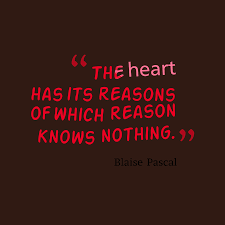 The story and the spreadsheet versus just the story or the spreadsheet.
The story and the spreadsheet versus just the story or the spreadsheet.For years the media business was driven by the belief that content was king. This began to be suspect as Google and Facebook and others hoovered up all the dollars proving that the people who could point to and drive traffic to content while capturing intent along the way were king.
Then the pendulum swung, and it all became data with Facebook combining excellent data skills that algorithmically transformed so-so content into an elixir that drove hundreds of billion dollars.
Netflix once had people believing it had a data sauce when its real success was driven by the genius of Reed Hastings to anticipate streaming, some first-class content they made for themselves and the nocturnal slumber of their content partners who woke up a decade later to understand they had been fueling their competitor with their content. Data played a part but just one part and by itself is no longer enough.
Now that Disney, HBO, and others have caught up it is clear there is no special data sauce and its back to pricing and content. This August it is going to be “House of the Dragon” HBO’s prequel to Game of Thrones versus Amazon’s “Power of the Ring” its Lord of the Ring’s spinoff versus Netflix “Sandman” and Disney “She-Hulk” combined with all sorts of pricing bundles.
The reality is that data and math of the spreadsheet matters. But so does meaning and the magic of storytelling.
TikTok combined the power of math (algorithms and teaching models) with music and movies (video) to create a juggernaut.
TikTok is an example of story and spreadsheet coming together in harmonic balance and every successful firm of the future will combine creativity and data, storytelling talent with data druids and technologists.
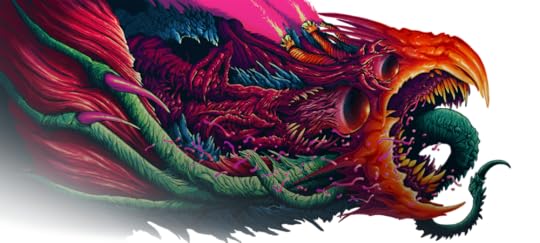 External forces intervene in every business.
External forces intervene in every business.Every individual and business plan are at the mercy of the four forces driving the future. These are the forces of multi-polar globalization (vs unipolar or western centric globalization), demographic change including media behavior, technology, and the long-term impact of Covid-19.
TikTok leveraged demographic shifts and technology of the second (mobile and social) and third connected ages (AI and 5G) to become what may be the future of entertainment and television. But the geo-political dynamics of multi-polar globalization and its pressures (ByteDance the owner of TikTok is a Chinese company) have limited its efforts to go public or buy a television network or more.
Geo-politics is the biggest near term challenge to TikTok.
Mark Zuckerberg was not being subtle when he shared a picturing of him surfing with an American flag in his hand…. Scott Galloway who is no fan of Mr. Zuckerberg has constantly brought up some Manchurian Candidate like scenarios that make him wary of TikTok too…
A reality every successful individual and company CEO and company should never forget: The external forces of globalization, technology, demographic changes and covid-19 must be contented with.
July 24, 2022
You=Start-Up.

Photography by Sandra Bartocha
Every individual, team and company might benefit from periodically going through an exercise of re-imagining themselves as if they were a start-up beginning again with a blank sheet of paper.
A time to consider this exercise is either when you feel you are at an impasse, or you sense a rapidly changing environment.
Even if neither of these occur re-thinking things every three or four years can be re-vitalizing in either confirming the contours of your life, company and career or adjusting without being under much external duress.

Photography by Sandra Bartocha
The Re-imagining exercise.The exercise consists of four steps.
Asset listing.
The real constraints.
Define/Select the challenge.
Re-invent and Re-Imagine.
The exercise should be done with a diverse (backgrounds, skill sets and more) group of people if you are doing this for a company or team but also if you are doing this for yourself.
If you are doing it as an individual re-thinking your future include at least two or three people besides yourself who know you well (a partner, a colleague, a mentor/old boss, a friend).
Diverse views ensure planning with a sense of upbeat reality versus delusional fantasy.

Photography by Sandra Bartocha
Asset Listing.Every individual, team and company have assets.
These assets may be depth of talent, financial wealth, heritage, expertise, skills, reputation, good will, clients, brands, family, connections, partners, distribution networks…
Sometimes an asset maybe you, your team and company have little to lose.
No one has nothing and often much more than we originally believed when we take stock.
List the assets.

Photography by Sandra Bartocha
The real constraints.Now list the constraints that you must live under and cannot get rid of under any circumstances.
Many constraints are works of imagination and not real constraints.
Usually there are only three real constraints for companies and teams and four for individuals.
a) The Law: You cannot break the law or do something illegal.
b) Science: You cannot pretend there is no gravity for instance or imagine technology that does not exist today.
c) Financial Reality: Limited funds or the need to break even in x number of years.
d) Family: For individuals doing this exercise an additional constraint is their family reality (which often is their biggest asset but limits optionality).
In most cases the constraints tend to be of the financial type and these need to be interrogated and not accepted at face value.
Gillette placed a constraint of protecting margins versus launching a lower cost blade and believed they could not cannibalize their existing retailer network by selling directly via subscriptions and therefore eventually suffered an 8-billion-dollar write-down due to losing share to Dollar Shave Club and others.
Another big constraint companies or individuals place on themselves is allowing themselves to be narrowly defined. We compete in this category which we define like this… (Hotels did not pay attention to Airbnb, auto companies did not pay attention to Tesla or Uber because they self-limited and self-curtailed themselves.)
If you do not have a skill, you can acquire it. If you company’s scale does not allow it to move fast you can start, fund and staff a smaller unit or buy a smaller unit.
Individuals often practice all sorts of self-limitation or self-curtailment such as pricing themselves out of their dreams by living a lifestyle that impresses others but robs them of their options or believing it is too late to re-imagine or re-start.
It is never too late to become who we want to be or are.
List the absolute constraints.

Photography by Sandra Bartocha
Define the Challenge.What is bothering you or creating a problem for your team or your company?
A new competitor creating a loss of market share? Category dynamics reducing your relevance or competitiveness in winning or keeping Clients? High employee turnover or inability to attract or retain clients? Stalling out at work and not growing?
Or it may be more of an opportunity?
How to scale and build expertise in a new category? How to deal with demand that you cannot meet or deliver with a certain quality slippage? How to take the plunge into a new career?
One of the most important steps in solving for a problem and coming up with a new solution is to ask the right questions. For more on this please read “The perils of asking the wrong questions”
Here are two ways you and your firm may minimize the risk of asking the wrong question:
1. Look at the question you are trying to ask and turn it around and see if it makes more sense.
Here is an example: Should you focus on how to get the cheapest arrows, or should you be asking how you can get the best archers?
Paying more for quality is always cheaper in the long run since it/they tend to work faster, think better, last longer and signal to your organization that you understand that buying cheap pigs maybe buying diseased pigs and could lead to poisoned hot dogs.
2. No question is off limits. Nothing is written. No sacred cows.
Time and time again we find that the idea for the next big thing was born in the last big thing, but the management of the last big thing squashed the idea since it did not fit in the business model.
Or we find that the problem was clear for all to see but was looked away from since it would mean the person who called it out might lose their job.
The brown moist thing in the middle of the table is not always a brownie it could be a turd. To ensure people call out the turd on the table please read “The turd on the table”.

Photography by Sandra Bartocha
Re-Invent and Re-Imagine.You can access any or all the assets you have listed.
Your only constraints are those of the law, the rules of science and some real “impossible to get rid of” constraints.
You have a clearly defined challenge.
Now imagine if you were starting with a blank sheet of paper.
How would you address the challenge being able to leverage all your assets but none of the stuff you do not want while working with the limited constraints.
Imagine you are a new competitor trying to disrupt or replace you.
With all your assets, none of your legacy thinking and limited constraints what would you do?
Everything is flexible.
You and the people who are working with you will come up with brilliant and compelling ideas because you will have changed your mindset in three ways.
a) You have gone from defense to offense.
b) You have stopped being constrained and anchored by legacy mindset and fear.
c) You have unleashed the creativity and positivity accompanying building and solving.
Once you have done this exercise and have generated one or two great ideas it is time to make them real and tangible in a hurry.
Why? If you have thought of something that could solve or address a challenge better than you are doing now it won’t be long till one of your current competitors or a new competitor puts it into motion.
To be a start-up one does not need to just think like a start-up.
But to take the plunge, act with urgency and move forward.
Just start.
July 17, 2022
The Future of the Internet
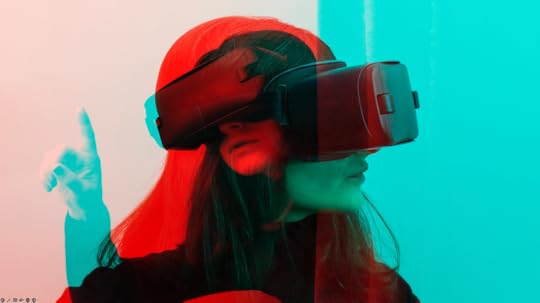
There are four seminal dates in the history of the Internet:
October 29, 1969: On October 29, 1969, at 10:30 PM, a computer grad student named Charley Kline at UCLA sent a message to SRI (Stanford Research Institute.) It was the first connection between computer networks.
We set up a telephone connection between us and the guys at SRI…
We typed the L and we asked on the phone,
“Do you see the L?”
”Yes, we see the L,” came the response.
We typed the O, and we asked, “Do you see the O.”
”Yes, we see the O.”
Then we typed the G, and the system crashed…
Yet a revolution had begun…
1 January 1983: January 1, 1983, is considered the official birthday of the Internet. Prior to this, the various computer networks did not have a standard way to communicate with each other. A new communications protocol was established called Transfer Control Protocol/Internetwork Protocol (TCP/IP). This allowed different kinds of computers on different networks to "talk" to each other. ARPANET and the Defense Data Network officially changed to the TCP/IP standard on January 1, 1983, hence the birth of the Internet. All networks could now be connected by a universal language.
6 August 1991: Tim Berners-Lee published the first ever website while working at CERN, the huge particle physics lab in Switzerland.
30 August 1993: CERN puts the World Wide Web software in the public domain. Later CERN made a release available with an open license, a surer way to maximize its dissemination.
Until 1993 the Internet (and its predecessors like ARPANET) were both difficult and highly limited in their use.
Beginning in 1993 due to CERN’s decision to make the World Wide Web software available to all with an open license we entered The First Connected Age when the world began its 30-year migration into cyberspace.
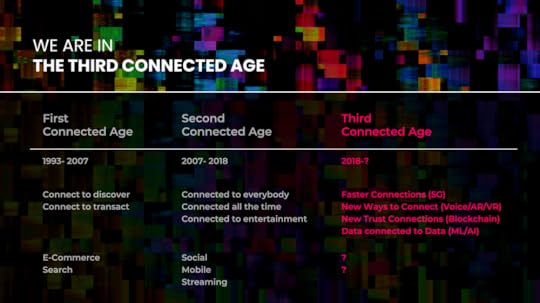 The Three Connected Ages.
The Three Connected Ages.In 1993 with the advent of the World Wide Web we entered The First Connected Age where we connected to discover and connected to transact. This is today known as Search and E-Commerce which are forces that have given rise to companies like Amazon and Google.
In 2007 we entered The Second Connected Age (which built on and did not replace The First Connected Age) when we were connected all the time, connected to everybody, and connected to entertainment, due to smart phones, social networks and affordable and pervasive broad band. These three advances which we call Social, Mobile and Streaming, have re-ordered society, politics and culture while creating juggernauts like Apple, Facebook and Netflix but also enabling everything from Uber to Airbnb to Dollar Shave Club to Spotify.
The world we live in today is hard to describe to someone thirty years ago.
But we have not seen anything yet…
Four new forms of connection will re-order society, work, and the future much more in the next decade than the past three decades.
These are the four new connections that will drive The Third Connected Age:
Data connected to data which is machine learning the form of AI that is most scaled.
Much faster and resilient forms of connection via 5G.
New ways of connecting including Voice, Augmented Reality and Virtual Reality.
New Trust Connection built on the Blockchain.
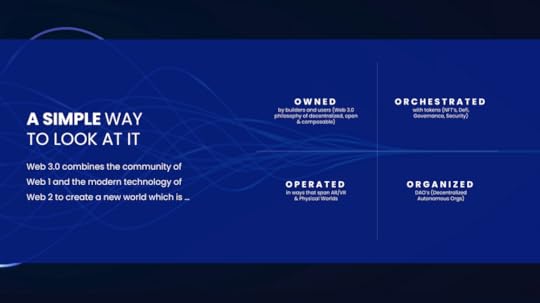 Web 3, Metaverse, Tokens and DAO’s are connected but not the same.
Web 3, Metaverse, Tokens and DAO’s are connected but not the same.The entire world of Web 3, Metaverse, Tokens/Wallets and DAO’s (all of which are different from each other but connected to each other) are just one subset of all the changes underway in The Third Connected Age.
Web 3 is as much an ideology as it is a set of technologies. The central tenets of Web 3 are Open, Decentralized and Composable. And a belief that the creators, builders, and users should have much ownership and benefits as investors and companies.
Tokens (NFT’s or Non-Fungible Tokens, are one type of many different types of tokens including Governance, Security and DeFi tokens. Tokens are often stored in wallets and this combination of tokens and wallets will help orchestrate ownership and value exchange.
Metaverse is a term that includes both Augmented Reality (AR) and Virtual Reality (VR). Augmented Reality layers the digital onto the physical (think of a head’s up display in a car) while Virtual Reality creates a simulacrum of the physical world in digital space. Just like Windows and MacOS were the operating systems of The First Connected Age joined by iOS and Android in The Second Connected Age there are billions being spent by Apple, Meta, Microsoft and others to create both hardware and software to operate between the physical and various manifestation of the digital world of The Third Connected Age.
DAO’s are mission driven communities with a treasury of tokens that enable ownership, governance and financial benefits that ideally will enable a more transparent, autonomous, efficient, and anonymous form of governance. It is the way the new world might be organized.
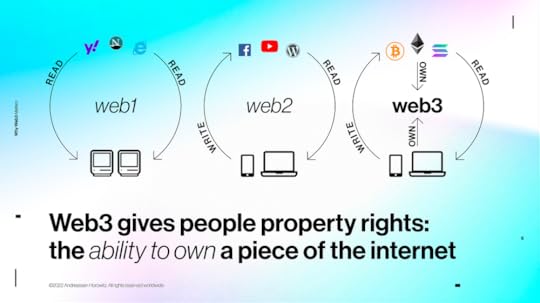 Web 3 Ideology.
Web 3 Ideology.The Internet was first designed to be decentralized enough to withstand a nuclear strike. By providing a free license to the World Wide Web CERN engendered a belief in openness. Composability accelerates innovation by enabling developers to build new use-cases on top of existing projects. The code of that new project, in turn, serves as yet another building block for someone else, leading to an ever-expanding library of code that developers can tap into to build their own ideas. Venture capitalist Chris Dixon describes it aptly when he wrote, “composability is the ability to mix and match software components like Lego bricks.”
While all of us have benefited from the Internet a significant part of the upside has gone to investors and some businesses but builders and particularly creators and users have shared very little of the wealth their content, their data, their networks, their attention, and time have enabled. Think of all the content, data, and time you give to Facebook. Zuckerberg buys islands in Hawaii, and you get to connect with other people and get likes!
The ideology of Web 3 is aligned with what most people want which is to be recognized and rewarded without being charged rents of 30 to 70 percent for the benefits of using a platform.
There will be middlemen and women in this new world. Consider them “enablers” who will make it easy for us to use the new technologies, to be discovered or provide other services but they are likely to charge a tenth of the total value created versus taking the large slices of todays “aggregators”.
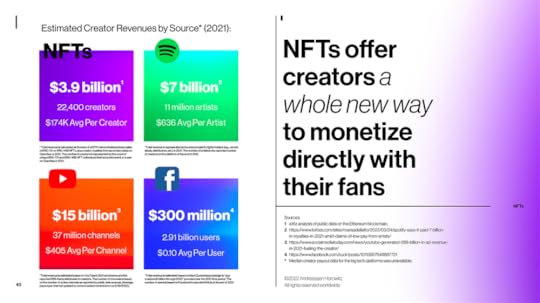 Tokens/Wallets.
Tokens/Wallets.Today most of the talk of tokens are one type of token which is the NFT but there are many other types of tokens. A way to think of tokens is that they provide some combination of four utilities: a) a currency, b) governance rights, c) membership and d) status.
An analogy to tokens that we may all be familiar with are airline miles. If you fly a lot, you get rewarded with airline miles which you can use as a currency. When you fly a lot, this currency gets you the status of a higher level and provides membership into lounges and clubs and the airlines pay more attention to what you think about how they govern themselves. Most tokens are like airline miles where one person’s airline mile on American is the same as another person’s airline mile on American and most tokens operate like this.
Non-Fungible tokens on the other hand add a form of uniqueness in that each one is different from each other and thus NFT’s have been particularly popular with the artist and creative communities. As the chart above shows NFT’s are significantly improving the rewards to people who create and their fans versus the platforms.
Tokens are usually collected and operated using wallets like Metamask. Increasingly many Web3 initiatives have a person signing in with their wallets and not their Facebook or Apple identities or their email.
Think of tokens and wallets as the future of identity and CRM (Customer Relationship Management) if you are a business leader or a marketer. This new age is dawning.
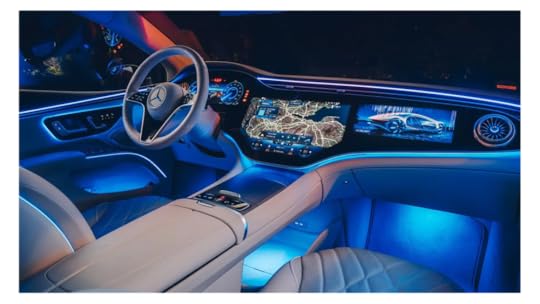 Metaverse.
Metaverse.In one way the Metaverse is here in the Web 2.0 world ,and it is called gaming. Gaming is a 155-billion-dollar industry (bigger than TV, Movies, Music combined) and is seen as the gateway to the next generation of Virtual Reality. It is why Microsoft is willing to pay 67-billion-dollars for Activision Blizzard and both Disney and Comcast were rumored to be interested in Electronic Arts. Netflix is likely to regret that it did not leverage its once valuable stock to buy a major platform like Sony bought Bungee.
Skeptics may snort “in your dreams” and the answer to that is that 14.8 million people are dreaming.
These are the sales to date of Meta’s Oculus Quest 2. (Try one or if you can afford one the $30 get one). Now imagine the technology getting exponentially better and possibly cheaper as the next generation from Meta and the products that Apple and Microsoft have in development are released by early 2024 if not before!
Terry Kawaja, founder of leading digital investment bank Luma Partners, shared an insight that given the VR/AR nature of the Metaverse we may first experience elements of it at scale in automobiles! Step into a modern electric car, particularly an electric one and you are in a world of screens with AR and Voice already deeply linked to its functionality.
It is not just technology but the underlying human need that these new technologies will enable that makes one believe of their future potential.
First, Humans want to have God-Like power.
The companies that enable us to cross distance and time such as Google which allows us to find anything with Search or visit places with Google Earth, or Apple that allows us to connect everywhere projecting our images and videos or Meta that enables us to connect for free or Amazon that brings the worlds bazaars to us have become the most valuable companies in the world.
At one time it was the railroad companies and oil companies and telephone companies that allowed us to bridge distance and time. Pharmaceutical and medical companies allow us to live longer lives.
These new Third Connected Age technologies will give us amazing powers and we will gravitate towards them just as we have in the past.
Second, they allow us to have multiple identities.
Our minds are imagination machines, and it has far outstripped the physical carrier of our bodies. Avatars and virtual worlds allow us to be a range of us and constantly re-invent and try on new lives and live in multiple worlds.
Third, we are about to see the greatest unleashing of human creativity as more and more people gain access to new ways to express themselves, to project their presence and be rewarded for their work.
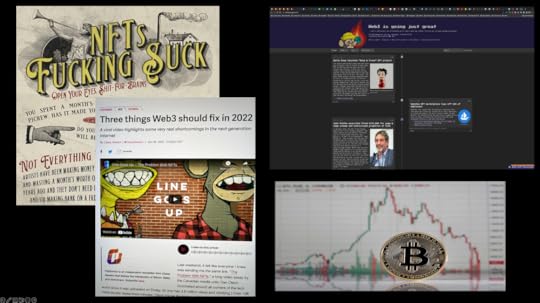 The Signal /The Noise.
The Signal /The Noise.There are many people who believe that the Web3/Token/Metaverse/DAO eco-system is some combination of BS, a Ponzi scheme promoted by a collection of hucksters, scammers and the delusion filled who are high on their own gas and maybe other substances!
Check out Molly White’s site that compiles many of these examples. Watch Dan Olson’s “The Line Goes Up Video” a brilliant take down of NFT’s. Read Scott Galloway. Monitor the headlines of Celsius and other companies going into bankruptcy. Measure the plunge in engagement of NFT markets or speak to anybody who invested in crypto for the first time beginning nine months ago.
The bubble has burst. Fake! Big balls of BS!
No practical use or problem solved.
An uncertain set of technologies in search of problems that do not exist.
Maybe.
There were and probably will still be many Ponzi schemes. Much of what is called Web 3 can be done without tokens, block chain or any of the new-fangled stuff. The Oculus Quest 2 while impressive is still rudimentary. Most coins will be and should always have been worthless.
But…
Remember 2000 to 2002 when the Nasdaq crashed from 5048 to 1114?
That was the noise.
Internet usage almost doubled from one third of all households to two thirds of households during the 1999 to 2003 period with massive increases in broad band connections.
That was the signal.
The crashing price of crypto, NFT’s and the revealing of scam artists is the noise.
Be smart. Read about all the stuff that is going wrong. Be wary.
But learn by getting involved at minimum as an individual (a lot of future opportunities are likely to be available to people who are conversant with the new landscape) and ideally as a company (organizations and people tend to adjust slower than technology so it’s not too early to begin to build centers of excellence and explore partnerships) and you may see some signals that reveal the amazing potential of what is next.
This signal maybe discerned in the hundreds of billions of dollars companies like Microsoft, Apple and Meta are investing in the space even today. Or the $4.5 billion A16Z raised for their oversubscribed Crypto Fund.
The fact that the best talent from the highest rated universities is going to Web 3 companies even this year in the middle of what looks like a meltdown.
That a spectrum of musicians from Nas to Chainsmokers have embraced the new world at Royal.io while Tom Brady, Tiger Woods, Wayne Gretzky and more have done the same at Autograph.io.
That many marketers are trying to understand the opportunities and challenges of tokens and wallets for the future of identity and CRM programs.
Or how companies like Nike recently having bought RTFKT and filed for several patents in Third Connected Age technologies.
Or how leaders everywhere are working to re-think their businesses such as Insurance companies wondering how to underwrite NFT losses or the purchase of Virtual Land.
There are a lot of signs that this is like 1993 and 2007 which marked The First and Second Connected ages which changed business, society a creating new opportunities and threats.
We are at the early days of what is likely to be the most compelling decade or more on the Internet.
Welcome to The Third Connected Age.
The Future of the Internet!
July 10, 2022
100!

This is the 100th edition of my thought letter!
For one hundred Sundays it has been offered as a “gift” that might be of some value by helping the reader see, feel and think differently about how to grow themselves, their teams and their business.
Like a gift, it was written in the hope that it would be shared freely and widely generating goodwill for the person who shared and for the writer in return for each reader’s valuable attention and time.
The thought letter has been 100% opt-in and its growth has been completely organic through its forwarding, sharing, re-posting on social media, re-printing on other platforms and word of mouth. No email lists were purchased and not a single dollar has been spent in advertising or promotion.
Beginning with about 100 readers the thought letter now enjoys a weekly readership of 25,000 people.
The most popular post “Re-Thinking Presentations” has been read over 100,000 times so far.
Other popular pieces reveal that there is a deep angst about the future of work (what is the future of the work? What is the role of offices? How does one manage a culture and what is culture in the first place? How does one balance the expectations and needs of different people and age cohorts? How does one adapt to distributed work? How will the next generation of technology change work?)
There is a great interest in the topic of career guidance in a transforming world (How to deal with change? How to manage a career? How to be a better leader? How to remain relevant and upgrade one’s skills in a world where knowledge has a shorter and shorter half-life? How to write a presentation or run a meeting?)
And there is a hunger for advice on how to grow as a person and get the most of time (What is success? How to become a better person? The importance of wisdom, dignity and connectedness.)
For this 100th post as a thank you to all the readers and to expose those who joined midway or later in the past two years to the topics covered, here is a curated list of the 40 posts that have resonated the most organized into a dozen key categories.
Have also created a page on my website so you can bookmark to it easily without needing to retrieve this email. As always thank you for your time and please feel free to share this post and/or the link to anybody you believe may benefit.
The rest of this post is best read and navigated here: https://rishadtobaccowala.com/100



